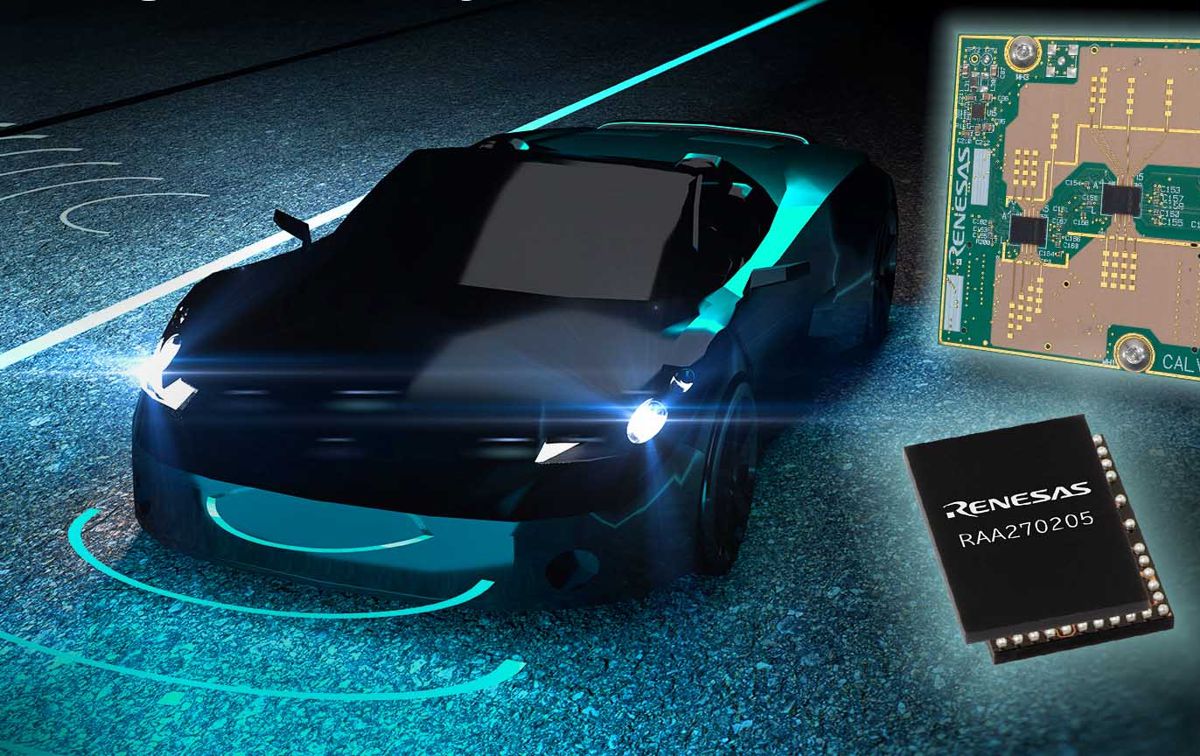Renesas Unveils First Family of Automotive Radar Transceivers with Industry’s Highest Accuracy and Lowest Power Consumption
Renesas Electronics Corporation, a premier supplier of advanced semiconductor solutions, is entering the automotive radar market with the introduction of a 4×4-channel, 76-81GHz transceiver designed to meet the demanding requirements of ADAS (advanced driver assistance systems) and Level 3 and higher autonomous driving applications. Leveraging automotive expertise accumulated through years of global customer engagements, Renesas will incorporate the new RAA270205 high-definition radar transceiver into its growing sensor fusion portfolio, which combines radar, vision systems, and other sensing modalities.
Designed in cooperation with Steradian Semiconductors Private Limited, which Renesas acquired earlier this year, the RAA270205 is featured in a Renesas product showcase at electronica, Munich, Germany, November 15-18, 2022. The new transceiver MMIC (monolithic microwave integrated circuit) is especially suited for imaging radar, long-range forward-looking radar and 4D radar, but can also be used for corner and central-processing radar architectures, the so-called “satellite” automotive radar systems. Equipped with 4Tx and 4Rx channels, the RAA270205 supports up to 16 MIMO (multiple-input and multiple-output) channels. It can be cascaded to enable higher channel count and better radar resolution.
The RAA270205 features best-in-class accuracy with up to 5GHz of bandwidth, and a 112.5MSPS ADC (analog-to-digital converter) sampling rate that is nearly three times faster than competing devices. Power consumption of 1.2W is 50 percent lower than comparable transceivers and it delivers a noise figure of 9dB, which is 3dB less than other radar transceivers. Its superior chirp rate of up to 300MHz/µs improves radar resolution and object detection.
“Today’s radar transceiver MMICs must achieve higher definition to support the high-accuracy requirements of ADAS and autonomous driving safety platforms,” said Vivek Bhan, Senior Vice President and Deputy General Manager of Renesas’ Automotive Solution Business Unit. “Working in close collaboration with Steradian, which brings deep radar design expertise, we are expanding our sensor fusion offerings with a focus on functional safety and low power consumption to help our customers lower their development costs and improve time to market.”

RAA270205 Winning Combinations
Renesas has plans to combine the RAA270205 transceiver with other compatible devices from its portfolio to support automotive radar systems. These Winning Combinations will include the “Satellite Radar System for AD/ADAS,” which will be available in Q2/2023. Renesas Winning Combinations are technically vetted system architectures from mutually compatible devices that work together seamlessly to bring an optimized, low-risk design for faster time to market.
Renesas offers more than 300 Winning Combinations with a wide range of products from the Renesas portfolio to enable customers to speed up the design process and bring their products to market more quickly.
Renesas to Bolster Low-Power WAN Product Line with NB-IoT-Capable Wireless Module
Renesas Electronics Corporation, a premier supplier of advanced semiconductor solutions, is expanding its low-power WAN product line as part of its strategy to deliver connectivity devices used for smart cities, smart homes, medical devices and industrial applications. The new RYZ024A supports Cat-M1 and NB-IoT (Narrowband Internet of Things) internet connectivity without the need for a gateway and consumes just 1µA (microamp) while in power savings mode, significantly less than competing products. The RYZ024A supports extended discontinuous reception (eDRX) and has an extended voltage range from 2.2V to 5.5V which makes it ideal for battery-powered applications. Renesas announced the details of the new product at electronica, Munich, Germany, November 15-18, 2022.
Similar to its predecessor, the RYZ014A module, the RYZ024A offers seamless Cat-M1 wireless connection capability, but the new module adds the option to integrate NB-IoT. While Cat-M1 and NB-IoT are both Low Power Wide Area Network (LPWAN) technologies, NB-IoT uses only a portion of the available spectrum, making it more power efficient and therefore extending the operational life of battery-powered systems. NB-IoT also offers excellent coverage depth, including underground and in enclosed spaces. The module provides two power amplifier output levels: 20dBm (decibel-milliwatts) and 23dBm, ensuring coverage at the cellular network’s edge as well as deep indoor environments.
The RYZ024A is being developed in collaboration with Sequans, a leader in cellular IoT technology, and will be fully tested and certified to work with all major radio frequency regulatory specifications defined by organizations such as the Global Certification Forum (GFC) and the PCS Type Certification Review Board (PTCRB). The certification ensures compliance with complex RF regulatory and carrier-specific requirements so that engineers can immediately start building IoT systems for leading carriers in North America, Asia Pacific and Europe.
“Cellular LTE-M and NB-IoT categories are now the de-facto wireless standards for connecting low-power IoT devices with global network coverage,” said Georges Karam, CEO of Sequans. “Renesas’ second-generation wireless module based on our Monarch 2 platform offers a certified hardware and software combination with all of the advanced features needed to accelerate the implementation of wireless IoT systems around the world.”
Renesas will provide all the tools and software that engineers need to design IoT-ready, power sensitive systems based on the RYZ024A, including an evaluation kit, a software stack and RF certifications. Compared to conventional chipset-based designs, designing in the RYZ024A module will reduce the PCB size by 60 percent and cut development time by up to 90 percent, since the product offers full hardware and software support to integrate the RA or RX family of MCUs.
“Renesas has been aggressively expanding its connectivity portfolio with strategic partnerships and acquisitions for the past five years,” said Roger Wendelken, Senior Vice President in Renesas’ IoT and Infrastructure Business Unit. “The RYZ024A is a great example of our expansive connectivity solution offerings that complement our broad range of embedded microcontrollers and microprocessors to deliver performance, scalability and exceptional reliability.”

RYZ024A Winning Combinations
Renesas has developed the “Solar Powered Location Tracker” solution, which is a modular asset tracking solution with flexible wireless options that efficiently transmit data. The solution is controlled by a central MCU (RA2L1) that balances low-power requirements, interfaces, performance, and flexibility. Along with complimentary Renesas products such as power ICs and communication modules for Wi-Fi (DA16600MOD), and Cat-M1 and NB-IoT module (RYZ024A), this solution provides connectivity options and an optimized power supply system that has been tested to accelerate development of tracker platforms. This solution is part of Renesas’ Winning Combinations, which optimally combine mutually compatible Renesas devices that work together seamlessly to reduce user design risk and shorten time to market. Renesas offers more than 300 other Winning Combinations with a wide range of products from its portfolio.
Renesas Lays Out Wi-Fi Roadmap Based on Technology from Celeno Acquisition
Wi-Fi 6/6E and 7 Chipsets for Client and Access Points Solutions in Development, Including Unique Doppler Imaging Technology Combining Connectivity and Sensing
Renesas Electronics Corporation, a premier supplier of advanced semiconductor solutions, today unveiled plans to deliver a comprehensive set of advanced Wi-Fi offerings to complement its broad portfolio of Industrial and IoT products. Renesas completed its acquisition of Celeno last year and is leveraging that technology to address a wide range of Wi-Fi client and access point applications for Wi-Fi 6/6E and Wi-Fi 7.
Today, Renesas is delivering production volumes of high-performance Wi-Fi 6E access point solutions with its CL8000 family.
Renesas is also sampling a powerful, highly integrated, 2×2 Wi-Fi/BLE combo chip supporting Wi-Fi 6E tri-band switchable radio (6GHz, 5GHz & 2.4GHz), 160MHz channel bandwidth and up to 2.4Gbps Data Link Speed. The new low-latency, highly secure chipset includes Bluetooth and BLE 5.2 support, and addresses multimedia streaming applications, IoT gateways and cloud connected devices.
Renesas is also developing a Wi-Fi 6E chipset with unique, patented Wi-Fi Doppler Imaging technology. This Wi-Fi Radar technology depicts the range and doppler signature of people and objects using standard Wi-Fi signals. It eliminates the need for multiple cameras or sensors in home environments and commercial buildings. For example, it can be used to detect the presence and location of people in a room to redirect and optimize air-conditioning flows, saving on energy costs. Another example could be intrusion detection to secured facilities or connected cameras with motion sensing to activate the camera. The combined connectivity and sensing chip is currently scheduled for production in the next 18 months.
Wi-Fi 7, also known as Extremely High Throughput (EHT), will deliver significantly faster throughput by employing faster modulations and double the bandwidth. In the 6GHz band, Wi-Fi 7 would more than the double the maximum speed and will increase speeds in the 2.4GHz and 5GHz band by as much as 30 percent. More importantly, some prominent features of Wi-Fi 7 will improve network reliability, latency and user experience. For example, by delivering Multi Link Operation, devices would monitor multiple links across different bands and provide consolidated operation to optimize interference and retransmission avoidance. Users will benefit from more reliable networks and from lower and more predictable latency. Wi-Fi 7 is expected to launch in 2024 with early adoption in mobile phones, computers and networking devices. Broader adoption in IoT, industrial and consumer multimedia applications will follow.
Renesas’ Wi-Fi 7 offerings will include solutions for home networking, IoT, industrial and consumer multimedia devices.
“Many recent developments are converging to create an era of market revolution in residential and enterprise Wi-Fi,” says Andrew Spivey, Industry Analyst at ABI Research. “Driven by a desire to take advantage of the new 6 GHz spectrum, which offers the prospect of greatly improved throughput and latency as well as reduced congestion on legacy bands, penetration of 6 GHz into Wi-Fi devices will rise rapidly in coming years. Meanwhile, the flourishing of new forms of Wi-Fi value added services such as Wi-Fi motion detection and the adoption of Wi-Fi 7 access points will accelerate following the protocols standardization in 2024, and just two years later, most 6 GHz enabled access point shipments will be supporting Wi-Fi 7.”
“Renesas can now offer truly differentiated Wi-Fi solutions that provide maximum performance, security and cost-competitiveness in combination with our industry-leading MCU and MPU offerings,” said Gilad Rozen, Celeno CEO and Vice President of Wi-Fi Connectivity in Renesas’ IoT and Infrastructure Business Unit. “Our customers are pleased with the direction we have chosen, and we are confident that we will deliver the right products for the market at the right time.”
“In the past year, we have completed three acquisitions that significantly augment our ability to sustainably provide intelligence from the cloud to the endpoint,” said Sailesh Chittipeddi, Executive Vice President and General Manager of the IoT and Infrastructure Business Unit of Renesas. “With Wi-Fi solutions from Celeno, low-power connectivity solutions from Dialog and embedded AI solutions from Reality AI added to our industry-leading embedded computing, analog and sensor portfolio, Renesas now offers customers complete, end-to-end solutions that are second to none.”

Winning Combinations
Renesas offers numerous Winning Combinations that combine Wi-Fi 6 and 6E chipsets integrated with a broad range of solutions from Renesas, including embedded processing, analog, power, timing and connectivity products. These engineering-vetted Winning Combinations will span applications from a High Throughput Wi-Fi 6 Router for home gateways to a Wireless IEEE 1588 Solution for 5G networks. More Winning Combos with Wi-Fi 6 are under development, including a Video IP Phone, Smart Home Security Terminal, and expansion of the Renesas Quick-Connect IoT Platform to include a Wi-Fi 6 USB stick for users to rapidly build prototypes.
In addition, a new Quick-Connect Wi-Fi 6 and Bluetooth Low Energy 5.2 module will be released for IoT applications that need a high bandwidth, high performance Wi-Fi 6 Client with 2×2 MIMO. This fully integrated, RF-qualified module will feature a flexible footprint with both PCIe and USB interfaces, saving engineering time and streamlining procurement for faster time-to-market.




















